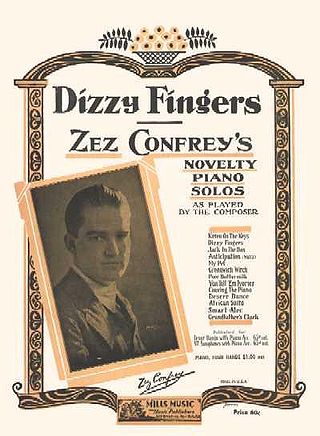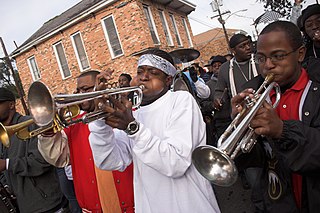Related Research Articles
Jazz is a music genre that originated in the African-American communities of New Orleans, Louisiana, in the late 19th and early 20th centuries, with its roots in blues, ragtime, European harmony, African rhythmic rituals, spirituals, hymns, marches, vaudeville song, and dance music. Since the 1920s Jazz Age, it has been recognized as a major form of musical expression in traditional and popular music. Jazz is characterized by swing and blue notes, complex chords, call and response vocals, polyrhythms and improvisation.
Jazz Dance is a performance dance and style that arose in the United States in the early 20th century. Jazz Dance may allude to vernacular Jazz, Broadway or dramatic Jazz. The two types expand on African American vernacular styles of dance that arose with Jazz Music. Vernacular dance refers to dance forms that emerge from everyday life and cultural practices of a specific community, often reflecting the social, cultural, and historical contexts of that community. In the context of African American culture, vernacular dance encompasses styles that developed organically within African American communities, influenced by African traditions, European dance forms, and the unique experiences of African Americans in the United States.

Ragtime, also spelled rag-time or rag time, is a musical style that had its peak from the 1890s to 1910s. Its cardinal trait is its syncopated or "ragged" rhythm. Ragtime was popularized during the early 20th century by composers such as Scott Joplin, James Scott, and Joseph Lamb. Ragtime pieces are typically composed for and performed on piano, though the genre has been adapted for a variety of instruments and styles.

Charles Joseph "Buddy" Bolden was an American cornetist who was regarded by contemporaries as a key figure in the development of a New Orleans style of ragtime music, or "jass", which later came to be known as jazz.

James Hubert "Eubie" Blake was an American pianist and composer of ragtime, jazz, and popular music. In 1921, he and his long-time collaborator Noble Sissle wrote Shuffle Along, one of the first Broadway musicals written and directed by African Americans. Blake's compositions included such hits as "Bandana Days", "Charleston Rag", "Love Will Find a Way", "Memories of You" and "I'm Just Wild About Harry". The 1978 Broadway musical Eubie! showcased his works, and in 1981, President Ronald Reagan awarded Blake the Presidential Medal of Freedom.

The cakewalk was a dance developed from the "prize walks" held in the mid-19th century, generally at get-togethers on plantations where Black people had been enslaved, before and after emancipation in the Southern United States. Alternative names for the original form of the dance were "chalkline-walk", and the "walk-around". It was originally a processional partner dance performed with comical formality, and may have developed as a subtle mockery of the mannered dances of white slaveholders.
Latin jazz is a genre of jazz with Latin American rhythms. The two main categories are Afro-Cuban jazz, rhythmically based on Cuban popular dance music, with a rhythm section employing ostinato patterns or a clave, and Afro-Brazilian jazz, which includes samba and bossa nova.

"The Saint Louis Blues" is a popular American song composed by W. C. Handy in the blues style and published in September 1914. It was one of the first blues songs to succeed as a pop song and remains a fundamental part of jazz musicians' repertoire. Benny Goodman, Louis Armstrong, Cab Calloway, Bing Crosby, Bessie Smith, Billy "Uke" Carpenter, Eartha Kitt, Count Basie, Glenn Miller, Guy Lombardo, Peanuts Hucko, Art Tatum, and the Boston Pops Orchestra are among the artists who have recorded it. The song has been called "the jazzman's Hamlet". Composer William Grant Still arranged a version of the song in 1916 while working with Handy.
Danzón is the official musical genre and dance of Cuba. It is also an active musical form in Mexico and Puerto Rico. Written in 2
4 time, the danzón is a slow, formal partner dance, requiring set footwork around syncopated beats, and incorporating elegant pauses while the couples stand listening to virtuoso instrumental passages, as characteristically played by a charanga or típica ensemble.

Noble Lee Sissle was an American jazz composer, lyricist, bandleader, singer, and playwright, best known for the Broadway musical Shuffle Along (1921), and its hit song "I'm Just Wild About Harry".
Afro-Cuban jazz is the earliest form of Latin jazz. It mixes Afro-Cuban clave-based rhythms with jazz harmonies and techniques of improvisation. Afro-Cuban music has deep roots in African ritual and rhythm. The genre emerged in the early 1940s with the Cuban musicians Mario Bauzá and Frank Grillo "Machito" in the band Machito and his Afro-Cubans in New York City. In 1947, the collaborations of bebop trumpeter Dizzy Gillespie and percussionist Chano Pozo brought Afro-Cuban rhythms and instruments, such as the tumbadora and the bongo, into the East Coast jazz scene. Early combinations of jazz with Cuban music, such as "Manteca" and "Mangó Mangüé", were commonly referred to as "Cubop" for Cuban bebop.
Contradanza is the Spanish and Spanish-American version of the contradanse, which was an internationally popular style of music and dance in the 18th century, derived from the English country dance and adopted at the court of France. Contradanza was brought to America and there took on folkloric forms that still exist in Bolivia, Mexico, Venezuela, Colombia, Peru, Panama and Ecuador.

Novelty piano is a genre of piano and novelty music that was popular during the 1920s. A successor to ragtime and an outgrowth of the piano roll music of the 1910s, it can be considered a pianistic cousin of jazz, which appeared around the same time. "Nola," a 1915 composition by New York pianist Felix Arndt, is generally considered the first novelty piano hit. Many early novelty composers were piano roll artists from the Chicago area, where two of the largest piano roll companies, QRS and Imperial, were based. While often only lightly syncopated or lacking syncopation entirely, novelty piano influenced the evolution of jazz. It is distinct from stride piano, which was developed in New York at about the same time.

Paul Hereford Oliver MBE was an English architectural historian and writer on the blues and other forms of African-American music. He was equally distinguished in both fields, although it is likely that aficionados of one of his specialties were not aware of his expertise in the other. He wrote some of the first scholarly studies of blues music, and his commentary and research have been influential.
The slow drag is an American ragtime jazz musical form and the social dance for which the music was written. It has been resurrected as part of blues dancing. Music written for the dance is often short-handed into the song title as a "Drag"

Vince Giordano is an American saxophonist and leader of the New York-based Nighthawks Orchestra. He specializes in jazz of the 1920s and 1930s and his primary instrument is the bass saxophone. Vince Giordano and the Nighthawks have played on television and film soundtracks, including the HBO series Boardwalk Empire and Woody Allen's musical comedy film Everyone Says I Love You.

The music of New Orleans assumes various styles of music which have often borrowed from earlier traditions. New Orleans is especially known for its strong association with jazz music, universally considered to be the birthplace of the genre. The earliest form was dixieland, which has sometimes been called traditional jazz, 'New Orleans', or 'New Orleans jazz'. However, the tradition of jazz in New Orleans has taken on various forms that have either branched out from original dixieland or taken entirely different paths altogether. New Orleans has also been a prominent center of funk, home to some of the earliest funk bands such as the Meters.

"Margie", also known as "My Little Margie", is a 1920 popular song composed in collaboration by vaudeville performer and pianist Con Conrad and ragtime pianist J. Russel Robinson, a member of the Original Dixieland Jazz Band. Lyrics were written by Benny Davis, a vaudeville performer and songwriter. The song was introduced by the Original Dixieland Jazz Band in 1920 as Victor 78, 18717-A, in a medley paired with "Singin' the Blues". The B side was "Palesteena". The ODJB recorded their instrumental version on December 1, 1920.
Tresillo is a rhythmic pattern used in Latin American music. It is a more basic form of the rhythmic figure known as the habanera.

"Ice Cream" or "I Scream, You Scream, We All Scream for Ice Cream" is a popular song, first published in 1927, with words and music by Howard Johnson, Billy Moll, and Robert A. King. After initial success as a late 1920s novelty song, the tune became a traditional jazz standard while the refrain "I Scream, You Scream, We All Scream for Ice Cream" has remained a part of popular culture even without the rest of the song.
References
- 1 2 "Vernacular Music Research – New World Music 1820s – 1960s". Vernacularmusicresearch.com. Retrieved 8 June 2023.
- ↑ "Sager, David – Jazz.com | Jazz Music – Jazz Artists – Jazz News". Jazz.com. Retrieved 2014-11-17.
- ↑ "The American Musical Landscape". Publishing.cdlib.org. Retrieved 2014-11-17.
- ↑ Matthiesen, B. (2008). Habaneras, Maxixies and Tangos: The Syncopated Piano Music of Latin America. Mel Bay Publications, Incorporated. ISBN 9780786676354 . Retrieved 2014-11-17.
- 1 2 "(No Title)". Upress.state.ms.us. Retrieved 2014-11-17.
- ↑ "COME AND TRIP IT | New World Records 80293 | Instrumental Dance Music 1780s-1920s" (PDF). Newworldrecords.org. 16 July 2002. Retrieved 2014-11-17.
- ↑ "Come & Trip It: Instrumental Dance Music 1780s-1920s". 2 August 1994 – via Amazon.
- ↑ Rick Benjamin (4 November 2003). "Black Manhattan Notes" (PDF). Newworldrecords.org. Retrieved 2014-11-17.
- ↑
- ↑ "[Dixielandjazz] Re: Copyright - "Copywrong"?". Ml.islandnet.com. 11 August 2004. Retrieved 2014-11-17.
- ↑ "The Devil's Horn: The Story of the Saxophone". Allaboutjazz.com. 11 February 2006. Retrieved 2014-11-17.
- ↑ "Google Books". Books.google.com. Retrieved 8 June 2023.